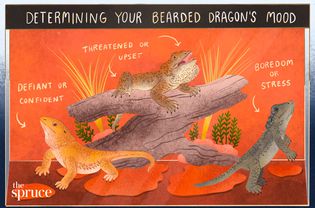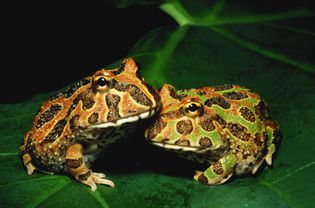Bearded dragons, or "beardies," are moderately sized lizards native to Australia, and they can make for a great pet. They range in color but are often a light tan to brown with a long, thick tail and a spiky, beard-like collar around their neck.
Though generally considered good pets, even for beginner reptile owners, they do have fairly complex nutritional and environmental needs. Special equipment and a fair amount of time are needed to care for bearded dragons. However, they are generally social and easy to tame, and they show a range of fascinating behaviors that make them interesting to watch.
Species Overview
Common Names: Bearded dragon, central bearded dragon, inland bearded dragon
Scientific Name: Pogona vitticeps
Adult Size: 16 to 24 inches long
Life Expectancy: Six to 10 years
Bearded Dragon Behavior and Temperament
Bearded dragons get their common name from the spines that encircle their necks. These spines usually lie flat. But if a dragon feels threatened, its throat will expand, and the spines will stand up. In captivity, however, bearded dragons are generally docile, so owners rarely see their aggressive displays. These animals are active during the day and typically learn to tolerate handling well. Many even enjoy perching on their keepers’ shoulders. However, male bearded dragons should be housed separately, as they can be territorial.
Click Play to Learn More About the Fascinating Bearded Dragon
What Type of Tank Is Best for Bearded Dragons?
For a single adult bearded dragon, a 55- to 75-gallon tank, along with a secure screen top, is ideal. Smaller tanks can be used for juveniles, but they will quickly outgrow them.
Bearded dragons are semi-arboreal (tree-dwelling) and sometimes like to perch off the ground. A selection of sturdy rocks, half logs, and branches can give them something to climb on, especially in the part of the tank used as a basking area. There should also be hiding spots, such as hollow logs, for your bearded dragon to feel comfortable.
Heat
Proper temperatures in the tank are extremely important. As with other reptiles, a temperature gradient should be provided for your bearded dragon, as well as a basking spot. The gradient should go from 80 to 85 degrees Fahrenheit on the cool side, up to a basking temperature of around 95 to 105 degrees Fahrenheit. Nighttime temperatures can fall to approximately 65 to 70 degrees Fahrenheit.
Heat can be provided via an incandescent light, ceramic heater, or a mercury vapor bulb in a dome reflector hood. You might need to experiment with wattage and distance from the tank to provide appropriate temperatures.
Use thermometers in the tank to monitor the temperatures at the basking spot, as well as at either end of the thermal gradient. Never rely on estimates. If necessary, an under-tank heater can be used to supplement the heat, especially at night if the room temperature is very low.
Light
Exposure to UV lighting is extremely important for pet bearded dragons. Special fluorescent bulbs can be found at pet stores that provide UV light. Your bearded dragon should be able to get within 12 inches of these lights to benefit from the UV emitted, depending on the type of bulb. Follow the manufacturer's recommendations. Moreover, the lights should be directed through a screen top rather than glass, as glass filters out some UV rays.
Maintain a consistent day-night cycle by providing roughly 12 hours of light and 12 hours of darkness each day. Placing the lights on a timer can be helpful.
Exposure to sunlight can also be beneficial. If time outdoors is provided, shade and shelter must be available, so your bearded dragon can thermoregulate. Never place your pet outside in a glass tank, as overheating will quickly occur in the sunlight.
Humidity
Bearded dragons prefer a humidity level of around 35% to 40%. This mimics their natural arid environment. Usually, this level is only difficult to maintain if you live in a high-humidity area. But if you do need to raise the humidity, you can mist your bearded dragon. Monitor the tank humidity using a hydrometer.
Substrate
Substrate is the material you place on the floor of your bearded dragon’s enclosure. It helps to maintain humidity in the environment, and it can give the tank a more natural look and feel.
For juveniles, loose substrate, such as sand, should be avoided. There is too great a risk of ingestion either accidentally or out of curiosity, and this can lead to intestinal impaction. Paper towels or reptile carpets can be used instead.
For adults, washed play sand (not fine silica sand) can be used, though paper towels or reptile carpets work fine, too. Do not use wood shavings, corn cob, walnut shells, or other substrates that could cause problems if swallowed. If sand is used, feces can be scooped out with a cat litter scoop. Sand allows bearded dragons to dig and burrow, which they enjoy.
How Often Do Bearded Dragons Eat Food and Drink Water?
In the wild, bearded dragons are omnivores, eating a mixture of invertebrate and vertebrate prey, including insects and smaller animals as well as plant material. In captivity, they should be fed a combination of insects and vegetables. Bearded dragons generally should be fed at least once every 24 hours, depending on their age. Baby bearded dragons often eat three times per day. Consult your veterinarian for the proper quantity of food, as this largely depends on your animal’s size.
What Do Bearded Dragons Eat?
Crickets that are fed to a bearded dragon should not be very large, especially for baby bearded dragons. Never feed any items bigger than the distance between the bearded dragon's eyes. For adult bearded dragons, you can offer a wider range of insects, such as waxworms, silkworms, butterworms, red worms, earthworms, newly molted mealworms, and superworms. Pinkie mice can also occasionally be offered to adults.
Insects should be gut-loaded (fed nutritious foods that pass to your pet) and lightly dusted with calcium and vitamin D supplements to prevent metabolic bone disease. Dust with a complete multivitamin no more than once a week.
In addition to insects, bearded dragons should be fed a mixture of leafy greens and other vegetables and fruits. These items can be chopped and mixed to make a salad, which can be fed in a shallow bowl. Leafy greens can also be clipped to the side of the enclosure.
Provide water to your bearded dragon in a shallow dish. If your dragon enjoys soaking in the water, you can offer a larger dish for it to climb into occasionally.
Common Health and Behavior Problems
One of the most serious ailments affecting bearded dragons is metabolic bone disease. This is the result of an imbalanced calcium-to-phosphorus ratio. It can lead to a softening of the bones, making them prone to fractures.
Like other reptiles, bearded dragons also are susceptible to respiratory infections. Symptoms commonly include wheezing or excess mucus around the nostrils and mouth.
Furthermore, bearded dragons are prone to impaction of the digestive system, often due to certain insects in their diet. This is especially true with crunchy bugs, such as mealworms. So it is best to feed these in limited quantities, especially to juvenile bearded dragons.
:max_bytes(150000):strip_icc()/bearded-dragons-as-pets-1236896_final-5ba293e746e0fb002575b7a2.png)
Choosing Your Bearded Dragon
Virtually all bearded dragons available in the United States are captive-bred, as Australia has strict laws against the exportation of its wildlife. This is ideal because wild-caught animals often fail to thrive in captivity. It's easy to find bearded dragons from reputable breeders or rescue organizations. Young dragons often cost around $50 while adults can cost around $100.
Select a bearded dragon that is active with healthy-looking skin. Some red flags include swollen joints; discharge around the eyes, nose, or mouth; discolored skin; and runny droppings.
What Species Are Similar to Bearded Dragons?
If you’re interested in similar pets, check out:
Otherwise, check out other types of reptiles and amphibians that can be your new pet.
-
How can you tell if a bearded dragon is male or female?
Shine a flashlight—the one on your phone works just fine—through the bearded dragon's tail. If it has two bumps inside, it's a male. One, and it's female.
-
Why isn't my bearded dragon eating?
There are several reasons why your bearded dragon isn't eating. If it's winter, it could be going through something called brumation. That's when it has a period of dormancy and hides in its substrate. Your dragon might also be starting to shed its skin, and you may notice it has a papery appearance.
Does your bearded dragon get enough UVB light? Without it, they will have bone loss, and not have appetites. Your dragon might also be cold; so check to make sure its enclosure is heated correctly.
If it's none of these, you might want to make a call to your exotics-focused veterinarian to find the root cause and fix it.
-
How do you bathe a bearded dragon?
Bearded dragons need to be bathed a couple of times per week. Bathwater should be no deeper than its knees, with water that's 85 to 92 degrees Fahrenheit. All you need to do is splash water on the dragon and let it enjoy itself in the water, no soaps are needed! After about 20 minutes, remove it from the bath and pat it dry. Get it back under its warm lights to make sure it stays toasty.
:max_bytes(150000):strip_icc()/LianneMcLeodDVM-sm-57bc34db5f9b58cdfd141649.jpg)
:max_bytes(150000):strip_icc()/184220290-56a2bccf3df78cf772796018.jpg)








